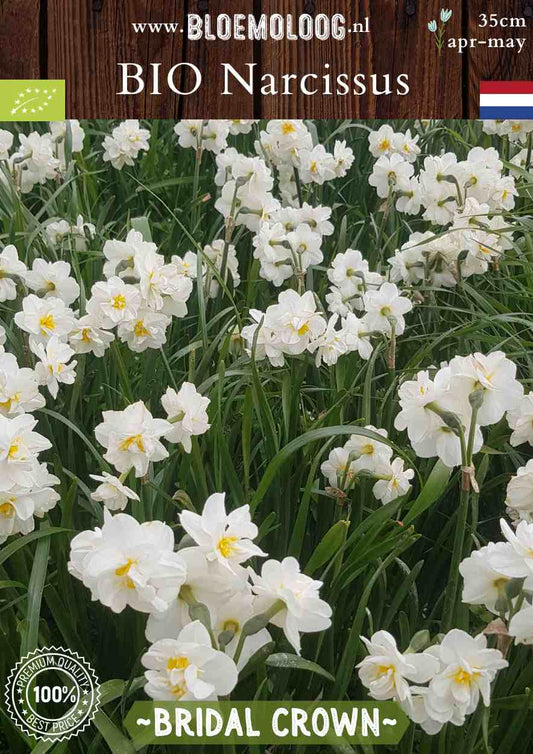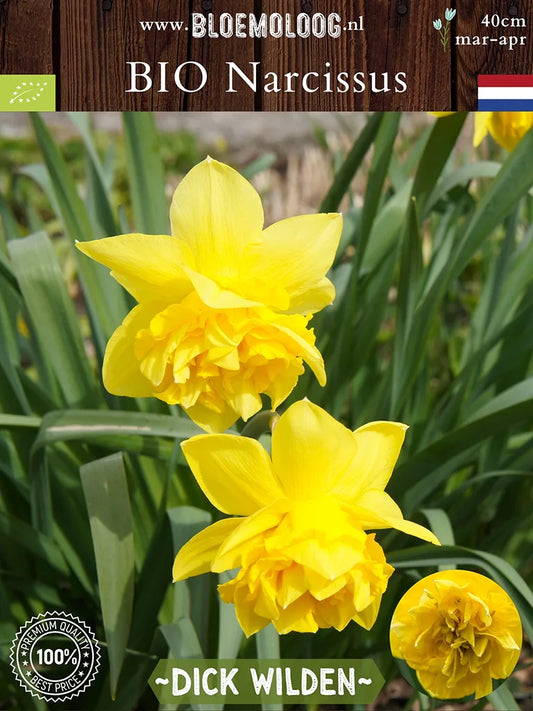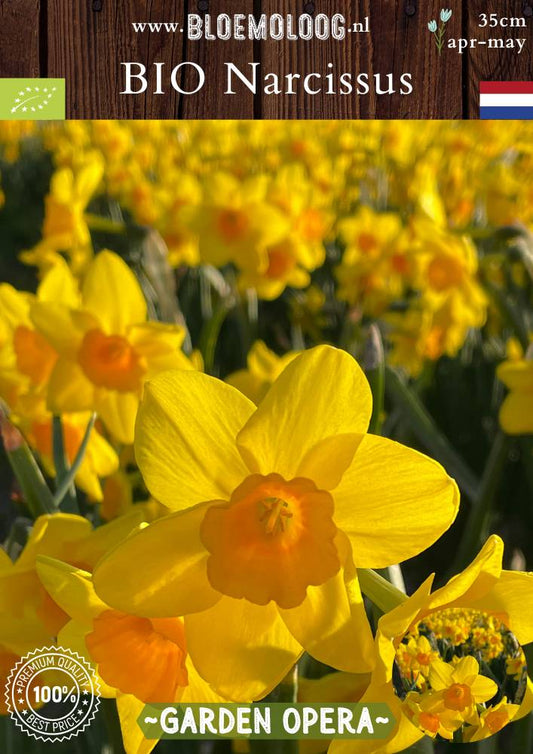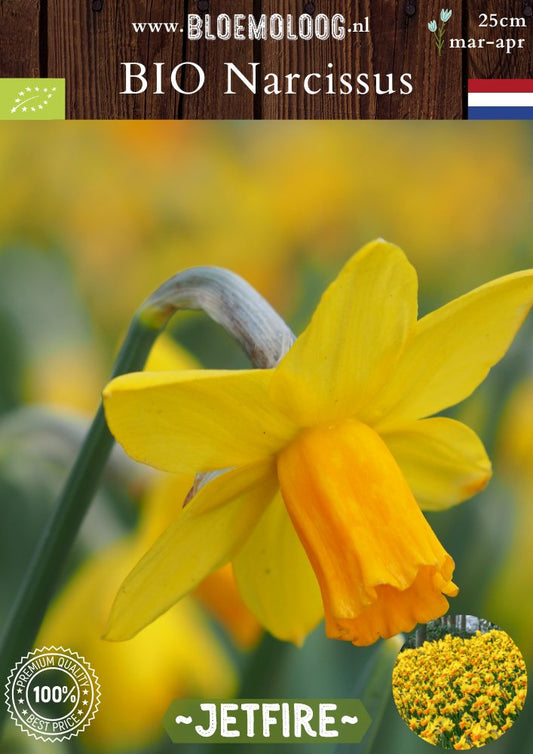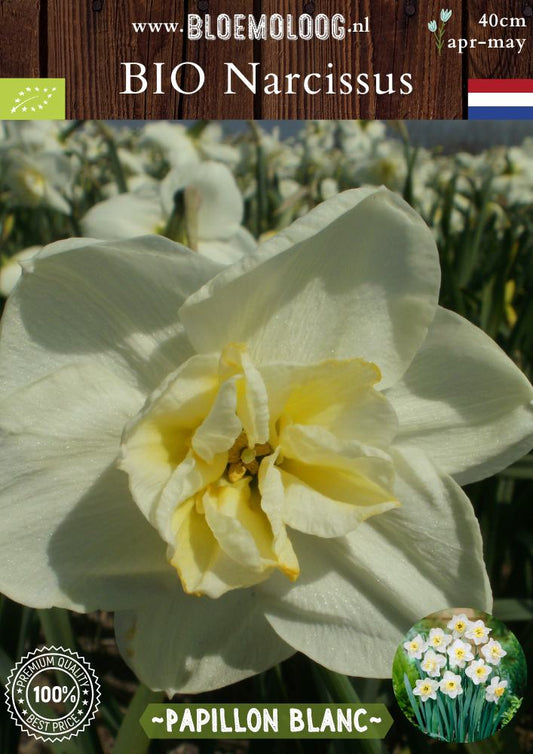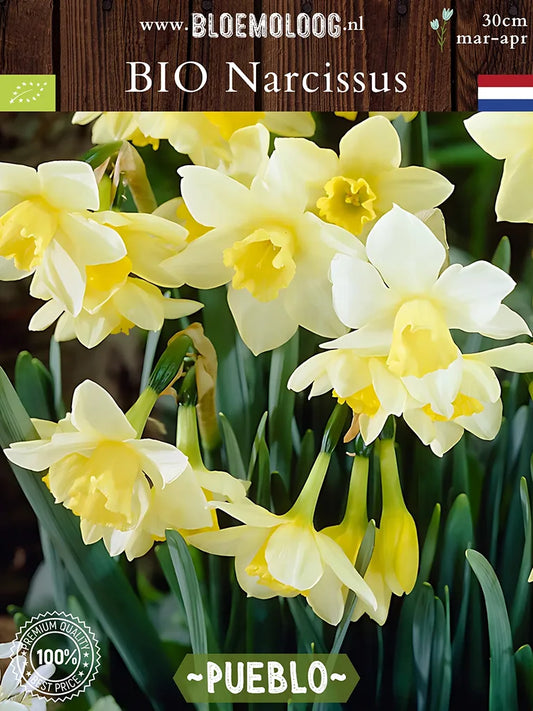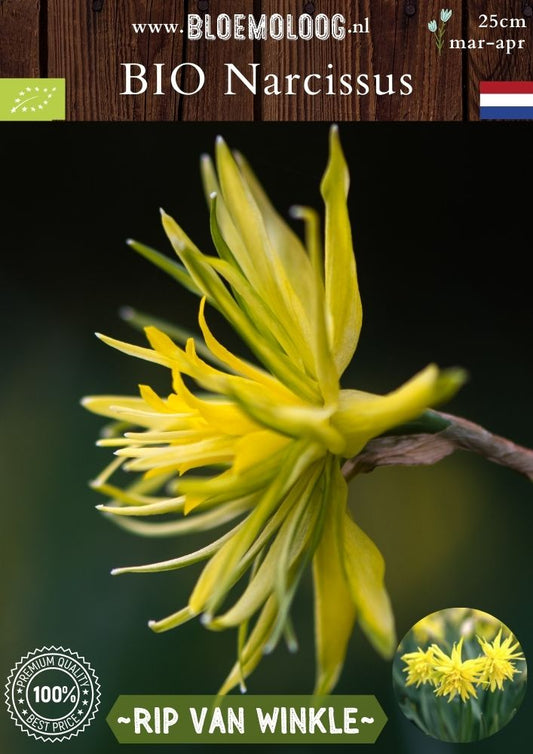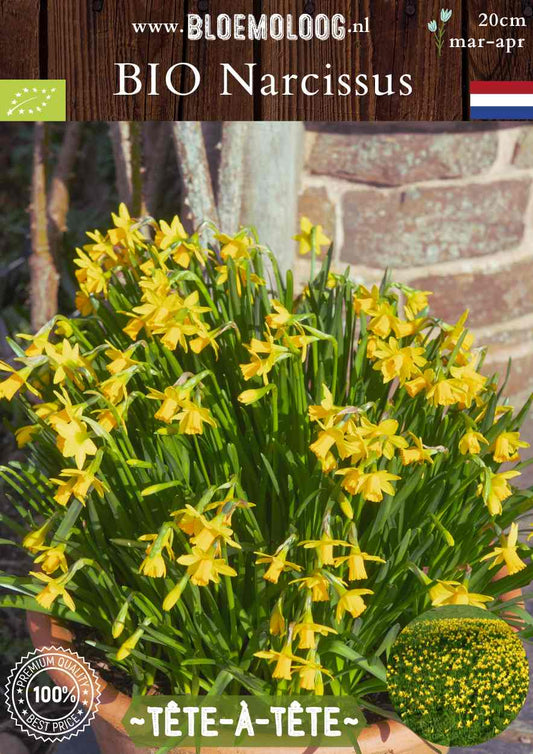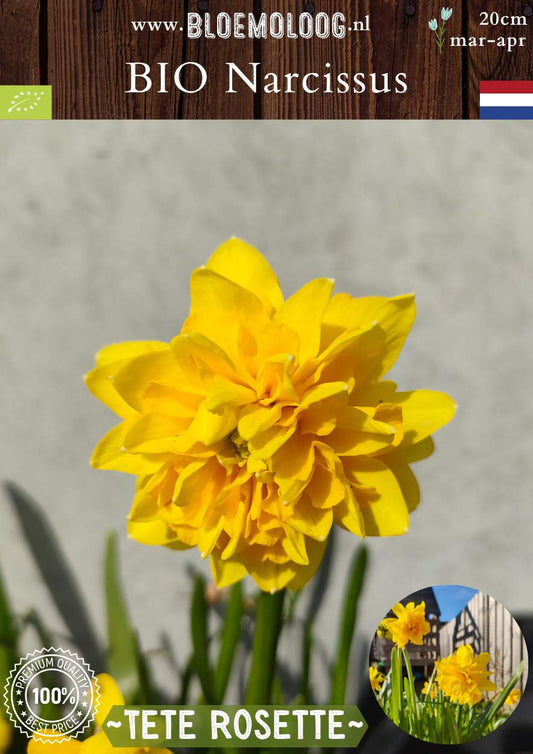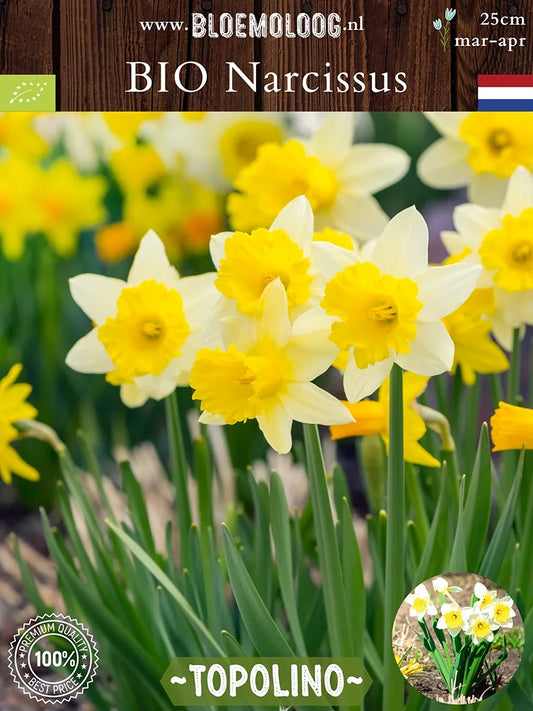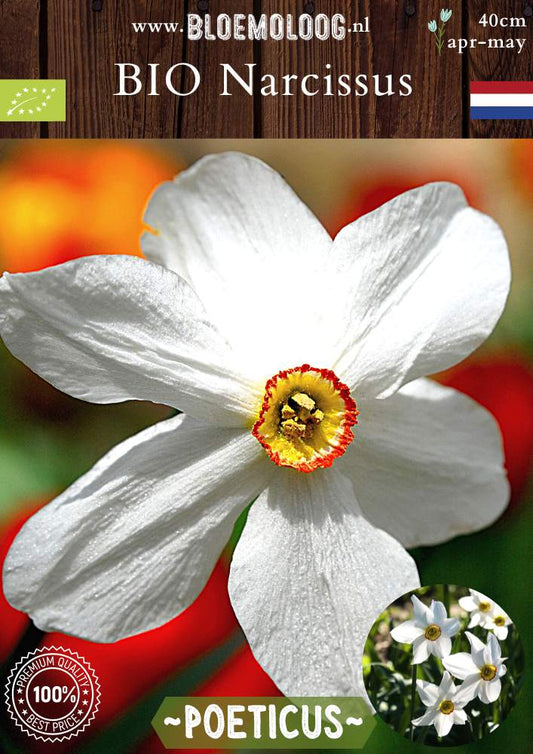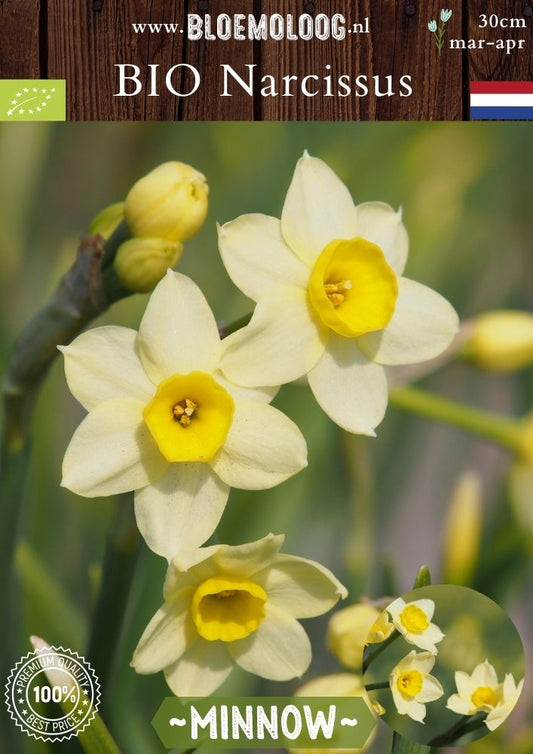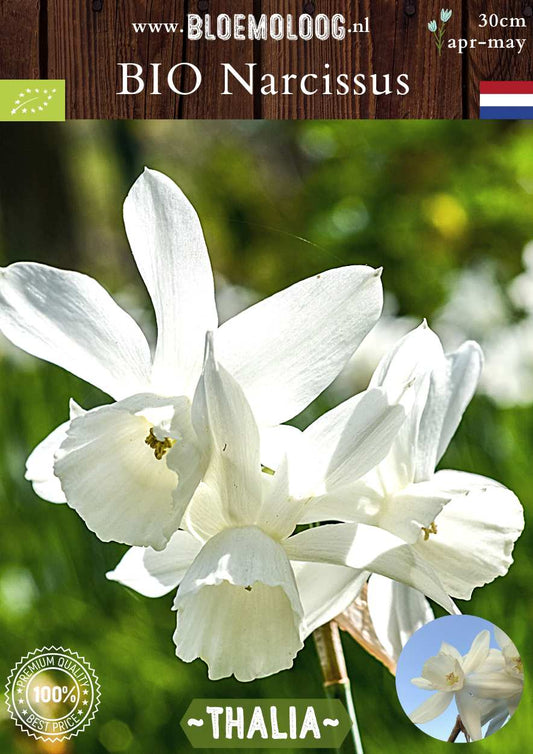
Collection: Organic daffodils
Organic daffodil bulbs
Narcissus , also known as the daffodil or the Easter flower, is a beautiful flower that symbolizes hope, renewal and beauty. These cheerful flowers belong to the family of the Amaryllidaceae and are characterized by their striking flower shape and vibrant colors.
The daffodil usually has a long flower stalk and produces one or more flowers per flower stalk. The petals vary in shape and color depending on the species. They can be known for their trumpet-shaped petals, wide calyxes or double-flowered flowers in various shades of yellow, white, orange, pink or even bicolor.
Fragrant daffodils
The scent of daffodils is also characteristic. They often spread a sweet and pleasant scent that adds to the overall charm of this bulbous plant. Our best scented varieties are the Narcissus jonquilla 'New Baby' and the Narcissus poeticus 'Recurvus'.
Daffodils flowering time
Another striking feature of daffodils is that they often flower in early spring, making them one of the first signs of approaching spring. They herald the end of winter and bring a sense of joy and hope. There are varieties that flower from January and in May there are still varieties that need a bit more warmth to flower. For this reason, we also recommend mixing daffodil varieties together and planting them in one large group, so that you can enjoy daffodils for longer.
Plant the bulbs in the autumn for beautiful flowering in the spring.
Location
Daffodils are relatively easy to grow and thrive in a variety of climates. They prefer well-drained soil and a sunny to semi-shaded position.
Cut flowers
Daffodils are also excellent flowers to cut for a vase. The flowers last a long time. Just don't combine them with tulips in the same vase. It is generally not recommended to put daffodils and tulips together in the same vase, because daffodils contain a substance that accelerates the aging process of other flowers. This substance is called "narcissin" and is found in the stems and leaves of daffodils.
When daffodils are placed in a vase with other flowers, such as tulips, the released narcissin can contaminate the water. This can cause the other flowers to wilt more quickly, lose their petals and generally have a shorter lifespan.
Therefore, it is best to arrange daffodils separately from other flowers in a separate vase or to combine them with flowers that are not sensitive to the influence of narcissine. In this way, you can optimally enjoy the beauty and longevity of both the daffodils and the other flowers.
Toxic
Although daffodils are beautiful to look at, it is important to know that they contain toxic components, especially in the bulb. These toxins can cause irritation to humans and animals, so it is wise to keep them out of reach of children and pets.
Where can I buy organic daffodil bulbs?
From June to January, organic daffodil bulbs can be ordered from Bloemoloog.nl. These are delivered from September during the planting season. From August to January, the organic flower bulbs can be picked out of the crates at our market stall.
-
Organic Hyacinthoides 'Excelsior' & Narcissus poeticus 'Recurvus' Mix | 20 pcs.
Regular price €12,95Regular priceUnit price €0,65 / per item -
Organic Narcissus 'Bridal Crown & Tulipa 'Novi Sun' mix | 14 pcs.
Regular price €11,95Regular priceUnit price €0,85 / per item -
Organic Narcissus 'Bridal Crown' - Bridal crown | 7 pcs.
Regular price €4,95Regular priceUnit price €0,71 / per item -

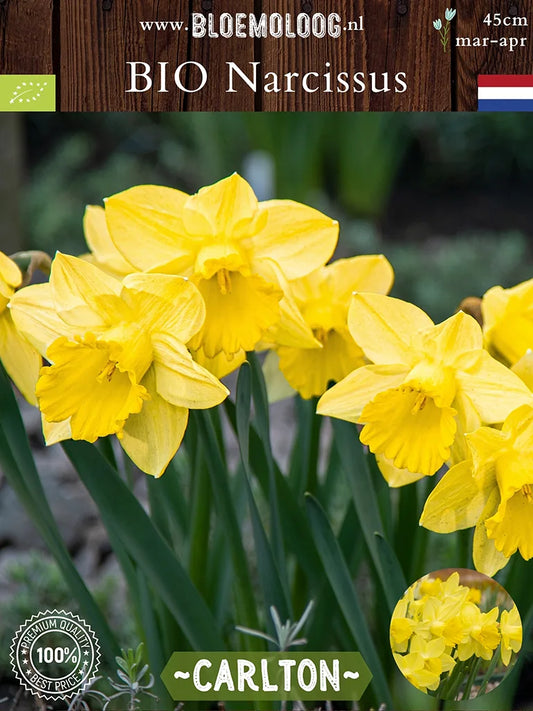 Sold out
Sold outOrganic Narcissus 'Carlton' | 7 pcs.
Regular price €4,95Regular priceUnit price €0,71 / per item -
Organic Narcissus 'Dick Wilden' | 7 pcs.
Regular price €6,67Regular priceUnit price €0,95 / per item -
Organic Narcissus 'Garden Opera' | 10 pcs.
Regular price €5,95Regular priceUnit price €0,60 / per item -
Organic Narcissus 'Jetfire' | 10 pcs.
Regular price €4,95Regular priceUnit price €0,50 / per item -
Organic Narcissus 'Papillon Blanc' | 10 pcs.
Regular price €4,95Regular priceUnit price €0,71 / per item -
Organic Narcissus 'Pueblo' - Botanical | 7 pcs.
Regular price €5,95Regular priceUnit price €0,85 / per item -

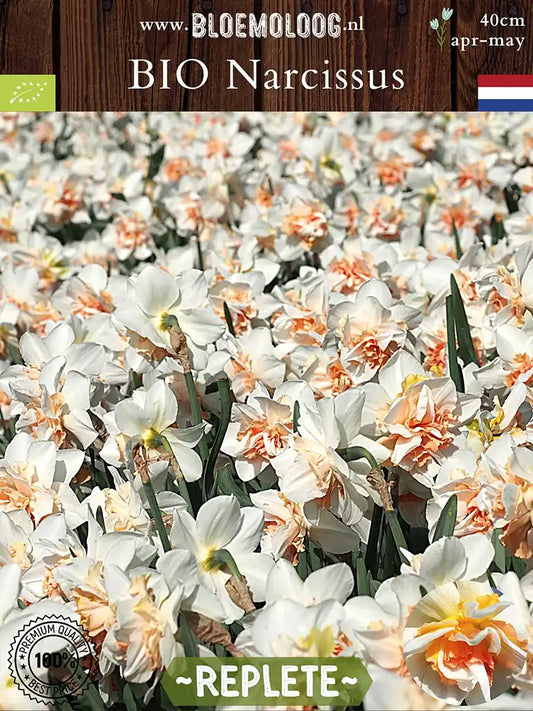 Sold out
Sold outOrganic Narcissus 'Replete' | 7 pcs.
Regular price €4,95Regular priceUnit price €0,71 / per item -
Organic Narcissus 'Rip van Winkle' | 10 pcs.
Regular price €4,95Regular priceUnit price €0,50 / per item -
Organic Narcissus 'Tête à Tête' - Daffodil | 10 pcs.
Regular price €4,95Regular priceUnit price €0,50 / per item -
Organic Narcissus 'Tete Rosette' - Double flowered dwarf daffodil | 7 pcs.
Regular price €4,95Regular priceUnit price €0,71 / per item -
Organic Narcissus 'Tête-à-Tête' & Muscari 'Armeniacum' mix | 20 pcs.
Regular price €9,95Regular priceUnit price / per -
Organic Narcissus 'Topolino' - Botanical | 7 pcs.
Regular price €5,95Regular priceUnit price €0,85 / per item -
Organic Narcissus jonquilla 'New Baby' | 10 pcs.
Regular price €4,95Regular priceUnit price €0,50 / per item -
Organic Narcissus poeticus 'Recurvus' - Poet's daffodil | 7 pcs.
Regular price €6,95Regular priceUnit price €0,99 / per item -
Organic Narcissus tazetta 'Minnow' | 10 pcs.
Regular price €4,95Regular priceUnit price €0,50 / per item -
Organic Narcissus triandrus 'Thalia' | 7 pcs.
Regular price €4,95Regular priceUnit price €0,71 / per item
-
Organic spring bulbs
Spring-flowering bulbs and tubers are popular plants that produce beautiful flowers from early spring through summer. Because of their early bloom, they combine well with perennials when they still need to establish themselves.
Tulips are probably the most well-known spring flowers. They come in many different colors, shapes, and sizes. Daffodils are known for their cheerful yellow flowers, but they also come in other colors like white and orange. Crocuses are small bulbous plants with striking flowers in shades of purple, yellow, and white. They are often the first flowers to appear in spring. Hyacinths have fragrant flowers in various colors, such as pink, purple, blue, and white. They are often planted in borders, flower beds, or pots.Benefits of organic spring bulbs
When you choose organic flower bulbs that bloom in spring, you can be sure that no chemicals or pesticides will end up in your garden. These pesticides are harmful to bees and prevent them from finding their nests. As a result, more and more bee species have been added to the red list in recent years. Together, we can do something about this!
Flower bulbs for wild bees
Did you know that wild bees lay eggs in their nests, which then hatch in early spring? These newborn insect helpers immediately search for food in the surrounding area. There are also insects that have hibernated and are desperately looking for a hearty breakfast: the blooming flowers where nectar and pollen can be found! Just after winter, there's little greenery or food for these insects. Planting early-blooming flower bulbs ensures there's food available, and the insects can gain strength for the coming summer.
Organic growers
The organic growers we work with cultivate not only the most beautiful but also the strongest products. They cultivate varieties and species of flowers and plants that experience has shown to be virus-resistant, so they don't need to use chemicals and pesticides. Organic growers seek natural remedies and solutions against diseases and/or pests. All our flower bulbs are certified organic; both the Florist and the growers are SKAL-certified.
When do you plant spring bulbs?
Spring-flowering bulbs can be planted from autumn until January. Bulbs that need to be dug up in the summer after flowering should be dug up starting in late July and stored until the next planting season in autumn.
What to do after flowering
When spring bloomers have finished blooming, cut off the wilted flowers at the top of the stem. Let the rest of the plant die back naturally so it can still receive maximum energy from the sun.
How do you store spring bulbs?
If you've purchased flower bulbs from us and had them delivered to your home and would like to leave them for a while, we recommend opening the box and storing it in a ventilated, cool place until you're ready to plant them.
Store flower bulbs you dig up after flowering in a warm place, such as a shed. To prevent mice from eating the bulbs during this period, you can also hang them in a bag or pantyhose. -
Where is the best place to plant spring bulbs?
Spring-flowering bulbs are flowers that bloom in the spring, between January and July. There are many different types of spring-flowering bulbs, suitable for different types of gardens and soil. For example, some bulb plants enjoy catching a glimpse of the sun during flowering, but prefer to be covered by a tree during their dormant period in summer.
Spring bloomers in the sun
Many spring bloomers need plenty of sun to bloom and grow well for the following year. These flowers thrive in full sun:
Spring bloomers in the shade
Some spring bloomers also grow and bloom well in the shade, such as:
Spring bloomers in moist soil types
There are also flower bulbs that can be planted in moist soil. Some varieties from the Florist's collection include:
Conclusion
There are many different types of spring bloomers suitable for different types of gardens and soil. Whether a spring bloomer can grow in sun or shade depends on the specific variety. Some prefer dry soil, while others prefer wet feet. So, there's a suitable spring bloomer for every garden.
Tips for a flowery garden
Plant a variety of flowers, each with its own blooming time, so there are flowers blooming throughout the spring and food for bees and other insects in your garden. Would you also like to arrange your garden/bed so you can enjoy flowers all spring long, and the bees too? Feel free to send us a message or ask us at the market stall. We're happy to help! Promote biodiversity in your garden and enjoy the first flowers and colors after the cold and dark winter!
Order spring bloomers in advance
Pre-sales for spring-flowering bulbs will begin on June 1st in the Bloemoloog webshop.
During the pre-sale, you can pre-order your desired products. This way, you can be sure your favorite flowers are still in stock, and we'll ship your package with PostNL as soon as planting time arrives.
Flower bulbs ordered in the pre-sale will be delivered in mid-September. From then on, they can be planted directly in the garden or in containers on the balcony.




